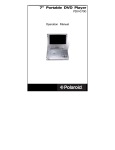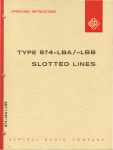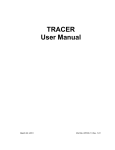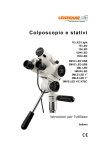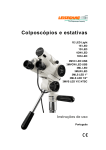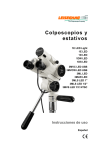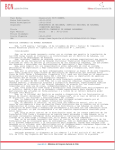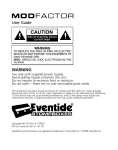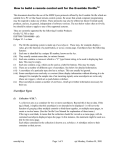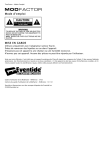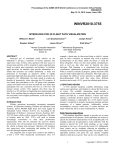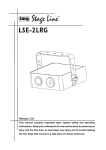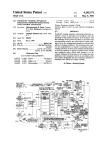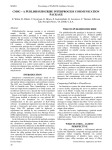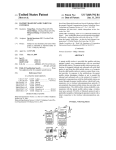Download ./ 11m
Transcript
US006564112B1 (12) United States Patent (10) Patent N0.: (45) Date of Patent: Factor (54) METHOD OF CUSTOMIZING ELECTRONIC SYSTEMS BASED ON USER SPECIFICATIONS US 6,564,112 B1 May 13, 2003 “Orville Presets V2.600” dated Aug. 18, 1999 (pp. 1—8) and tWo—page document entitled “Read Me First!”, dated Aug. 18, 1999, Eventide, Inc. (75) Inventor: Richard Factor, Kinnelon, NJ (US) OrvilleTM Programming Manual (Eventide, Inc., part No. 141035, Manual Release 1.1, Jul. 28, 1999, pp. 1—97 (entire (73) Assignee: Eventide Inc., Little Ferry, NJ (US) document). (*) OrvilleTM Modules Manual (Eventide, Inc., part No. 141035a, Manual Release 1.1, Jul. 29, 1999, pp. 1—98 (entire Notice: Subject to any disclaimer, the term of this patent is extended or adjusted under 35 U.S.C. 154(b) by 0 days. document)). VSIGFILE User Manual V1.0 (Eventide, Inc., Jan. 13, 1997, (21) Appl. No.: 09/437,771 (22) Filed: pp. 1—22 (entire document)). NOV. 8, 1999 * cited by examiner (51) Int. Cl.7 .............................................. .. G06F 19/00 (52) US. Cl. .... .. (58) Field of Search ............................ .. 700/94, 95, 97, .. 700/97; 700/95; 703/13; 716/1 700/103, 104, 105; 703/1, 13; 705/26; 716/1, 5, 16 (56) Primary Examiner—Leo Picard Assistant Examiner—Paul Rodriguez (74) Attorney, Agent, or Firm—Ostrolenk, Faber, Gerb & Soffen, LLP (57) References Cited ABSTRACT A method and system for manufacturing a particular system U.S. PATENT DOCUMENTS based on a universal system. The method includes designing 5,068,823 A * 11/1991 Robinson ................... .. 716/16 the particular system on the universal system. The particular 5,812,414 * Butts et a1. system as implemented on the universal system is then A 9/1998 ....... 5,966,310 A * 10/1999 Maeda et a1. ...... .. 6,006,195 * Marchak et a1. A 6,167,383 A 12/1999 * 12/2000 . . . .. 703/13 345/866 ..... . . . .. 700/95 Henson .................. .. 703/13 6,202,197 B1 * 3/2001 Robinson et a1. . 6,236,901 B1 * 5/2001 703/14 Goss ................. .. 361/692 6,249,714 B1 * 6/2001 Hocaoglu et a1. 6,393,591 B1 * 6,438,435 B1 * 5/2002 Jenkins et a1. ..... .. 714/725 8/2002 Wada et a1. ................ .. 700/97 700/28 OTHER PUBLICATIONS tested. The system is re-designed and re-tested until the particular system as tested on the universal system is accept able. The ?nal design of the particular system is sent to a manufacturer to be built using the elements of the universal system used to implement the particular system. After the manufacturer receives the design of the particular system as implemented on the universal system, it identi?es the ele ments of the universal system used to implement the par ticular system. The particular system is constructed using OrvilleTM Operating Manual (Eventide, Inc., part No. 141032, Manual Release 1.1, Jul. 28, 1999, pp. 1—111 (entire those elements of the universal system. 9 Claims, 8 Drawing Sheets document). EXTERNAL INPUTS 70 r \ l E l l 1'1 t‘776 M1 M2 ‘M3 0 o 0 MN P 003519114]? ./ 11m EXTERNAL OUTPUTS 14 21 U.S. Patent May 13, 2003 Sheet 1 of 8 US 6,564,112 B1 EXTERNAL 10 ‘ INEUTES g ' \ ,H/ 76 J! i J}- J M1 M2 1M3 0 a a MN P z 4/ " r;i / n u 21 O 0 I] U / 20 / E mi lg [F 0 _ a ,2/ l l l 1W8 EXTERNAL FIG. 1 ourpurs CUSTOMER MANUFACTURER XYZ CO. [1D 0 % COM " [1E] 22 — POWER PENSATION ‘CHANNEL FIG. 2 U.S. Patent May 13, 2003 Sheet 2 of 8 US 6,564,112 B1 CUSTOMER DESIGNS A PARTICULAR SYSTEM ON A UNIVERSAL SYSTEM CUSTOMER TEsTs THE PARTICULAR SYSTEM AS IMPLEMENTED ON THE UNIVERSAL SYSTEM L-— CUSTOMER SATISFIED WITH THE TEST REsULTs NO ?_ CUSTOMER RE-DESIGNS THE PARTICULAR SYSTEM 0N THE UNIVERSAL SYSTEM YES CUSTOMER SELECTS ONE OF A NUMBER OF FRONT PANELS OFFERED BY A MANUFACTURER HAVING A CONFIGURATION OF CONTROL INTERFACES(KNOBS,BUTTONS, ETC.) AND ADAPTS THE DESIGN 'OF THE PARTICULAR SYSTEM SO THAT ITS ADJUSTABLE VARIABLES INTERFACE WITH THE CONTROL INTERFACES, AND DESIGNS LABELS AND ART WORK FOR THE PANEL SELECTED. CUSTOMER SEND'S THE DESIGN OR SELECTION ' THE PARTICULAR SYSTEM AND THE DESIGN OF THE FRONT PANEL TO A MANUFACTURER FIG. 2a U.S. Patent May 13, 2003 Sheet 3 of 8 US 6,564,112 B1 MANUFACTURER RECEIVES DESIGN OF THE PARTICULAR SYSTEM AND THE FRONT PANEL MANUFACTURER IDENTIFIES THE ELEMENTS OF THE UNIVERSAL SYSTEM NEEDED TO IMPLEMENT THE PARTICULAR SYSTEM MANUFACTURER CONSTRUCTS THE MANUFACTURER PARTICULAR SYSTEM USING THosE ELEMENTS OF THE PARTICULAR SYSTEM AS IMPLEMENTED IN THE UNIvERsAL SYSTEM TESTS THE PARTICULAR SYSTEM AND TROUBLE SHOOTS SYSTEM, IF NECESSARY MANUFACTURER CREATES LABELS AND OTHER ARTWORK FOR THE FRONT PANEL SELECTED BY THE CUSTOMER MANUFACTURER INTERFACES THE ADJUSTABLE VARIABLES OF THE DESIGNED SYSTEM WITH THE CONTROL INTERFACES OF THE PANEL SELECTED BY THE CUSTOMER FIG. 2b U.S. Patent May 13, 2003 Sheet 4 of 8 US 6,564,112 B1 MANUFACTURER TESTS THE COMPLETED SYSTEM MANUFACTURE TROUBLESHOOTS AND CORRECTS PROBLEMS IN THE COMPLETED SYSTEM, IF ‘NECESSARY i MANUFACTURER DELIVERS THE COMPLETED SYSTEM TO THE CUSTOMER FIG.- 2c U.S. Patent May 13, 2003 FILTER PC PROGRAMMING INTERFACE US 6,564,112 B1 Sheet 5 0f 8 PHASE SHIFTER AMP /40 EXTERNAL USER INTERFACE INPUT INTERFACE P42 FIG. 3a EXTERNAL OUTPUT INTERFACE AUDIO OUTPUT AUDIO INPUT — -- n AMP FILTER in FIG. 3 b 42 AUDIO INPUT 40’f PHASE SHIFT _--~ FILTER --- AMP PHASE] SHIFT v AUDIO OUTPUT U.S. Patent May 13, 2003 Sheet 6 6f 8 US 6,564,112 B1 DISPLAY 9 9 9 / I I KNOB 1 KNOB 2 KNOB 3 \\'% I’ O 3C ACME \UOII 1‘ (Hz) ACME Q‘ 1, \C‘j, f(Hz) % FIG. 3e DISPLAY U.S. Patent May 13, 2003 Sheet 7 of 8 US 6,564,112 B1 “Ll 15M] FINZ >J [> ourzl FIG. 4 v18 O MODFILTER O . Fl 50 FIG. 5d U.S. Patent May 13, 2003 Sheet 8 0f 8 @ [1N1 >]_\‘\ 50 US 6,564,112 B1 > 0M2) 58 / [DA / 4 8 MODFILTER \ LFO FIG. 5b ~48 “480 FIG. 5c MODFILTER PARMS A: EMPTY FREQ:0.0 Hz FREQ‘ MOD:0.0 Hz q: 1.0 q, M'OD:0.0 MODFILTER LFO FIG. 5e US 6,564,112 B1 1 2 METHOD OF CUSTOMIZING ELECTRONIC SYSTEMS BASED ON USER SPECIFICATIONS outputs from the chips. At a fundamental level, the DSP may be programmed With a large set of modules, Which each contain a digital processing capability, general control func tion and/or a mathematical function. In addition, DSP manu facturers may create and store a set of DSP processing BACKGROUND OF THE INVENTION program segments, each of Which provides a certain sound, effect, or other function for the user. These segments, or 1. Field of the Invention The invention relates to methods and systems for “presets”, are generally comprised of one or several mod ules. The user typically has the ability to alter the parameters designing, ordering and customizing electronic systems. In particular, it relates to creating a customiZed electronic 10 sally con?gurable system. 2. Related Art Creation of customiZed electronic systems is common and Wide-ranging. In one Well-knoWn example, military contrac tors are provided With detailed speci?cations by the Defense Department; the systems are subsequently designed, con structed and delivered to the customer (i.e., the Defense An example of such a DSP is the OrvilleTM Audio Effects 15 viding digital signal processing capabilities, general control and/or mathematical functions. The OrvilleTM includes hun dreds of presets (alternatively referred to as “programs”) con?gured in various Ways to provide a menued array of Other familiar examples include construction of semi customiZed computer systems such as those offered by the particular computer and ships it to the customer. The reverbs, pitch shifters, distortion, dynamics, equaliZation, phasing, ?anging and other music and production effects. 25 customer, hoWever, has a limited number of stock compo nents to choose from and cannot test the ?nal system prior to its construction and delivery. Electronic systems, such as audio systems, also have longstanding practices of customiZation based on the user’s has a number of input interfaces. Using a menu on the face of the OrvilleTM, the user can adjust the parameters (or variables) of the preset. For example, if the preset is a loW pass ?lter, the user can adjust the frequency cutoff. The user can also store the preset With the adjusted parameters as a 35 separate customiZed program. Digital signal processing units may also be programmable, thus alloWing the user to create his or her oWn effects, instead of being limited to the presets or lishments have also provided construction of complete sys programs chosen by the manufacturer. For example, the OrvilleTM is also programmable by the user. By using programming accessed via the front panel of the OrvilleTM, or by using softWare supplied by the manufacturer that is tems or components based on a customer’s design, or its oWn design based on a customer’s description. All of these various schemes also suffer from the draWback that the ?rst time the customer hears or otherWise evaluates the system or component is after it is constructed and delivered. Electronic systems currently exist that incorporate a Wide range of features, functions and capabilities. Some such systems alloW a user to design a particular system by The user can thus invoke the presets of the OrvilleTM via a menu to exploit their intended effect. For effects that operate on external inputs (as opposed to, for example, effects that are entirely generated internally), the OrvilleTM needs. Often an audiophile or a musician becomes familiar enough With a system or component to make the change him or herself, often by trial and error. Commercial establish ments have also offered customiZation services of existing systems or components, based on the user’s design or description of the end sound or result. Commercial estab Processor by Eventide, Inc., the assignee of the present invention. The OrvilleTM is a programmable, multi-channel, digital signal processor. The OrvilleTM has tWo processors and also includes numerous electronic modules, each pro Department in this example). GateWay Computers. The customer can order a computer tailored to his or her needs, selecting items such as processors, drives and modems. The company then builds or variables that are used in the presets. For example, for a ?lter preset, the DSP alloWs the user to change the frequency parameters of the ?lter. Depending on the particular DSP function invoked, external inputs may or may not be needed. system based on a user speci?cation created using a univer loaded onto a PC, the user may construct a desired con?gu ration of the modules of the OrvilleTM by selecting the 45 modules used, creating the inputs and outputs betWeen modules and adjusting the parameters of the modules. The con?guring and customiZing programmed features Within the system, and then testing the con?guration. In addition, softWare also alloWs the user to assign parameters to the knobs and other manual controls on the front panel of the some systems permit the user to program a particular’system OrvilleTM, thus giving the user the ability to manually adjust these selected (adjustable) parameters (such as gain, output channel, etc.) for the designed effect. Meters (such as simulated meters, including LCDs) displaying certain parameters (such as amplitude) may also be programmed for using more elemental features supported by the system, and the programmed con?guration may also be tested. If the con?guration is acceptable, the system so con?gured may be implemented for its desired purpose. If not, it can be recon?gured by re-programming the system until accept able. If the speci?cations change over time, or become unnecessary, the system may be recon?gured to the neW speci?cations or reimplemented in a completely different 55 designed effect from the modules. The execution (or “build”) of each such effect is done by creating program con?guration. ming that links the various modules together in the manner designed by the user. The build takes only a feW seconds, A prominent example of an electronic system described immediately above are programmable digital signal proces sors (DSP), including digital effects processors. Early effects processors used analog circuitry and devices, along With knobs and other sWitches for adjusting parameters. For example, shift registers Were used for delay and circuitry Was used for frequency adjustment. With today’s DSPs, a microprocessor interfaces With DSP chips and are programmed to create the desired effects and display on the front panel of the OrvilleTM. Once the effect is designed, the design is doWnloaded to the microprocessor of the OrvilleTM, Which “builds” the thus giving the user a near simultaneous experience of the effect. The user can experiment by making quick changes to the design and immediately experience the effect. 65 The programmability of the OrvilleTM and like DSPs alloWs the user to experiment by implementing effects that may be more complex than the presets. For example, the user may combine modules to have a ?lter folloWed by a US 6,564,112 B1 3 4 delay followed by a phase shift. The effect may be imme diately built and tested. Adjustments may be made to the parameters of the effect, or it can be re-designed and Alternatively, the user may design and supply the manu facturer With a completely custom design of the front panel, including a completely custom layout of knobs, buttons, immediately re-tested. displays, etc. selected by the user for the front panel. These knobs, buttons, etc. likeWise provide the control interface While electronic systems that incorporate a Wide range of betWeen the user and the adjustable parameters of the features, functions and capabilities, including those that are con?gurable, such as the Orville TM, provide the advantage of alloWing the user to design and/or test particular functions, particular system. and then to recon?gure the system as desired at a later time, the user to implement the particular system in a stand-alone they have a number of disadvantages. Such “universal” device. Only those constituent capabilities of the universal system needed to support the particular system are included in the implementation, con?gured as speci?ed by the user. In particular, hardWare and/or softWare from the universal system that is not needed to support the particular system is largely or completely excluded. The manufacturer also creates the front panel for the particular system based upon the design sent by the user. As noted above, this may be one of a number of particular panel con?gurations offered by the manufacturer that the user adapts to the designed system. Alternatively, it can be a The manufacturer uses the design speci?cations sent by systems are often relatively expensive, since they include softWare and/or hardWare that provide the user With so many options. Implementation of particular effects using the uni versal system is thus a costly and inef?cient use of the device, because the true poWer of the universal system is its 15 capacity to develop effects. For example, a small studio may have a number of particular effects that it Wants to imple ment and regularly use over an extended period of time. Implementing a number of effects using one or a feW OrvillesTM requires (at least) re-programming the OrvilleTM and integrating it in the particular setting for the desired effect. This is (at best) time consuming and tedious. It can completely customiZed panel designed by the user for the system. The unit created by the manufacturer also has input and output connections that interface With the designed delay production, or, When more simultaneous effects are needed than available OrvillesTM, limit the desired produc tion. Generally, a small studio Will not have (or be Willing to system, as Well as the labels, calibrations and other artWork 25 supplied by the user. When complete, the stand-alone unit is expend) the resources to purchase a separate OrvilleTM to implement each effect. Finally, use of the OrvilleTM to implement effects can hinder the Work of those developing tested and then delivered to the user. neW effects. products. The customer uses the comprehensive universal system as a design and testing tool, but does not use it to The method is an extremely ef?cient and economical method and system for constructing highly customiZed end SUMMARY OF THE INVENTION actually implement particular systems. The customer may use only a small fraction of the capabilities of the universal The invention includes a commercial method of custom iZing a particular system from a universal system having numerous constituent capabilities that, are con?gurable. The user designs a particular system and implements the par system in the design of the particular system. In addition, the 35 ticular system by accessing and con?guring the universal system. The user then tests the particular system as con?g ured. If the test results indicate that the particular system is acceptable, then the con?guration is not changed. If the test results are not acceptable, then the universal system is to manufacture the particular system and the cost of manu facturing and delivering the particular system can be a fraction of the cost of the universal system. In addition, because the particular system delivered to the re-con?gured and the particular system as re-con?gured is tested until the resulting particular system is acceptable. Once a design con?guration of a particular system is found acceptable by the user, as described further beloW, the design speci?cation is then sent by the user to a manufac particular system is built in an economical manner by being implemented using only the standardiZed constituent com ponents (such as hardWare and/or softWare) of the universal system that are needed. Thus, only a short time is required customer uses the same constituent components as the 45 turer for construction of an individual unit based on the design. The user is thus also the “customer” of the manu facturer and the terms “user” and “customer” Will be used universal system and is con?gured in the manner designed by the customer, it Will perform identically to the one that Was implemented and tested by the customer on the univer sal system. This substantially reduces or eliminates cus tomer dissatisfaction and returns of the delivered system, Which also contributes to an overall reduction in manufac turing costs. Also, because the front panel is customiZed by the interchangeably (and sometimes together) in the description beloW. The “manufacturer” includes any person(s) or entity that performs the services as described beloW. In particular, hardWare and/or softWare from the universal system that is not needed to support the particular system as designed by customer, Who uses his oWn artWork, the delivered system also looks customiZed for the customer and/or his or her business. Customer satisfaction With this aspect of the the user is excluded. 55 delivered product Will also be high, again reducing the associated With customer dissatisfaction and returns. The manufacturer also offers one or a number of front panels, Which include buttons, knobs, displays, etc., BRIEF DESCRIPTION OF THE DRAWINGS arranged in one or more standard con?gurations. These FIG. 1 is representative draWing of a universal system used in accordance With the present invention; buttons, knobs, etc. may be used to provide control of the adjustable parameters and inputs of the particular system designed. The user (customer) adapts the designed system to FIG. 2 is a representative draWing of a con?guration of a particular system and cabinet design sent by a customer to a manufacturer for building; Work With one of the front panel arrangements, thus pro viding external inputs and control signals to the system. As FIGS. 2a—2c is a ?oWchart representing an embodiment part of the speci?cations sent to the manufacturer, the user includes legends and calibrations for the knobs, levers, meters, etc. for the chosen panel. The user also supplies artWork for the front panel, so that it Will look customiZed. cost 65 of the present invention; FIG. 3a is a representative draWing of a programmable digital signal processor; US 6,564,112 B1 5 6 FIGS. 3b—3e are representative drawings of the design and implementation of a particular system and front panel in accordance With the present invention; FIG. 3f is a representative drawing of the design and implementation of a particular system in accordance With the present invention the individual modules M1—Mn and/or presets supported by the universal system 10. A data cable 22 connects the PC With the interface 14 of system 10. SoftWare loaded into the computer 20 alloWs the user to design and construct a particular system by con?guring individual modules and/or presets of the universal system 10. Once the particular system is designed, the softWare in the PC sends instructions FIG. 4 is a vieW of an initial PC screen of softWare used to the processor P of the universal system 10. universal to program a DSP; system 10. A data cable 22 connects the PC With the FIGS. 5a—5d are subsequent vieWs of a PC screen of 10 interface 14 of system 10. SoftWare loaded into the computer 20 alloWs the user to design and construct a particular softWare being used to design a particular system on a DSP; and system by con?guring individual modules and/or presets of the universal system 10. Once the particular system is FIG. 56 is a vieW of an area of a DSP Where parameters FIG. 1 shoWs a universal system 10 having external inputs designed, the softWare in the PC sends instructions to the processor P of the universal system 10. The processor P executes the instructions received from the PC to con?gure the designed system. Processor P may either directly use the softWare from the PC, or may generate its oWn softWare based bn that received from the PC. Where 16, outputs 18, a set of user interfaces 12 and a computer processor P, for example, interfaces With the inputs and interface 14. System 10 also includes a plurality of modules outputs of analog electronic components or elements of the universal system, processor P may interface With sWitching hardWare, for example, to arrange the necessary connections betWeen the elements or devices, also incorporating the processor P itself in implementation of the particular system, if necessary. Where the universal system 10 includes mod ules and/or presets that are supported via hardWare logic and of the particular system designed in FIGS. 5a—5d are adjusted. 15 DETAILED DESCRIPTION M1, M2, . . . Mn. Modules M1—Mn may include electronic devices or elements, such as ampli?ers, transistors, transformers, gates, etc., or larger systems comprising such devices or elements con?gured together. They may also include programmed features supported by hardWare logic 25 (chips, etc.) and softWare in the system 10. A universal system 10 may have modules comprised of each type of the softWare, processor P may use the program from the PC to invoke the particular programming for the module and/or presets at the appropriate time, also directing data generated above-described exemplary elements, i.e., both analog and digital modules. by one module to another, When necessary. Processor P may The system 10 also includes a processor P that interfaces With the modules, as further explained beloW. Processor P also interfaces With the set of user interfaces 12, as also also direct any necessary data supplied at the external inputs 16 to the appropriate module(s), When necessary. (As noted above, processor P may alternatively generate its oWn soft Ware corresponding to the design based on the design explained beloW. Processor P includes programming for invoking the indi vidual modules and/or pre-programmed arrangements of 35 tWo or more modules. FolloWing the terminology introduced received from the PC.) If necessary, the programming executed by processor P also con?gures user interfaces 12 With the system designed above, such programming for invoking individual modules by the user. The user interfaces 12 are a set of knobs and and/or pre-programmed arrangements of tWo or more mod ules are referred to as “presets”. The presets may be selected through a menu on the user interface 12, Which also alloWs the user to adjust parameters or variables for the presets through the menu itself and/or knobs, buttons, etc. on the user interface 12. A preset may include simply invoking a module by itself, or may include more complicated pre sWitches that can be con?gured as part of the particular system to provide manual control of parameters of the particular system provided by the user. Processor P may programmed con?gurations of modules, With one module’s output supplying the input to another module or modules. When the modules are supported by hardWare logic (supported, for example, on chips) and softWare, the pro con?gure a user interface to provide a direct input to a module or modules or a preset, or the processor P may receive the input from the user interface and (after 45 appropriate module or preset. Processor P thus utiliZes the modules and/or presets of the universal system in the manner designed by the user. Con ?guring the particular system can also incorporate the pro cessor P itself in implementation of the particular system. cessor P interfaces With the hardWare logic and runs a stored program corresponding to the preset. The processor P directs data to and from the various hardWare logic needed for executing the preset and also accesses input at the external inputs and the user interface (if any) for use in the process ing. Processor P also directs output of the preset to the external outputs. If analog components are utiliZed in the universal system, then processor P may interface With a netWork of sWitching devices (such as transistors, relays, etc), Which are con?gured by softWare in the appropriate manner. If a preset chosen by the user requires external input(s), processing, if necessary) provide an appropriate input to the The softWare instructions generated and/or compiled by processor P may be stored in memory of the universal system 10 for later applications. Thus, particular systems may be implemented by the user 55 via the universal system in a number of Ways. In one case, the user may simply invoke one of the presets of the universal system and customiZe the adjustable parameters for the preset. In another case, the user designs a particular system by con?guring modules and/or presets. The particu lar system designed may also include user control over the programming of processor P selects one or more of the adjustable parameters of the modules or presets and also designate Which knobs, buttons, etc. on the user interface 12 external inputs 16 and con?gures it to receive the external input(s). Processor P directs the output(s) of the preset Will supply the control. The particular system may also include external inputs to the modules or presets used in the chosen by the user to one or more of the external outputs 18. 65 design supplied at external input interface 16. It may also A computer 20, such as a personal computer (PC), may also be used by a user to design particular systems based on include external outputs from the modules or presets used in the design supplied to external output interface 18. US 6,564,112 B1 7 8 Once a particular system has been designed by the user and implemented Within the universal system 10, the par ticular system is tested by the user. This may be done, for designed. If the front panel 24 shoWn in FIG. 2 is one of a number of standard front panels offered by the manufacturer 26, then the customer is shoWn to have adapted the “% compensation” parameter of the system to interface With the left knob, the “channel” parameters to interface With the central buttons and the “poWer” parameter to interface With the right button. The customer also designs and sends the example, through a menu on the user interface 12. The user may provide required inputs to the particular system through the external input interface 16 and may control certain adjustable parameters of the particular system via the knobs, buttons, etc. on the user interface 12 con?gured as part of the labels for the controls, the calibrations (not shoWn) and the particular system. Output from the particular system is via other artWork for the panel, such as the company logo and color. The diskette 22 and the front panel design 24 are sent by external output interface 18. If the user is not satis?ed With the results (output) and/or 10 controls of the particular system designed, the particular system may be re-designed using the computer 20 and the user (customer) to a manufacturer 26 for construction, as softWare supported therein, as described above. The re-designed system may then be sent to processor P and implemented in the universal system, also as described above. The re-designed system may be tested and, if not to the user’s satisfaction, re-designed in the same manner until it is. The re-design may include recon?guration of the inter connections betWeen modules, inclusion of additional design 24 may also be included in a softWare ?le on the also represented in FIG. 2. (As noted above, the front panel 15 lar system from the diskette 22. Based on those design speci?cations, the particular system is implemented in a separate cabinet using those modules, presets and supporting hardWare (such as a processor) required by the particular modules, adjustments to the external inputs, ?xing certain parameters at different ?xed levels, redesigning and/or reca librating parameters that may be controlled by the user, etc. When the user is satis?ed With the particular system system. The particular system as built includes at least those 25 designed and tested, the particular system is de?ned by the particular con?gurations betWeen the modules and/or presets, the ?xed parameter settings, the adjustable parameters, the external inputs, etc. These speci?cations are contained in the program designed by the user on the computer 20, Which may be doWnloaded onto a diskette 22. The user also knoWs What external inputs are required, What parameters of the system may be adjusted by the user, and What external outputs are generated by the system. As described beloW, the user Will send all the design speci? diskette 22.) The manufacturer 26 is knoWledgeable of the universal system 10 and, in particular, the modules and presets comprising the system. The manufacturer 26 retrieves the customer’s design speci?cations of the particu modules, presets and supporting hardWare required to sup port the particular system and, preferably, no more. The modules, presets, and any supporting hardWare and softWare are con?gured and/or programmed as speci?ed in the design. In addition, the manufacturer constructs a front panel for the cabinet according to the customer’s front panel design 24. As noted above, Where the manufacturer 26 offers a select number of front panel con?gurations, the customer 35 has adapted the designed system so that the adjustable parameters of the system correspond to the particular knobs, buttons, etc. of a selected panel, such as the front panel 24 panels. Each con?guration offered may have, for example, con?guration shoWn in FIG. 2. Also, the customer supplies, the calibrations for the controls, the function labels and the artWork for the panel. Thus, the manufacturer 26 connects different numbers and types of control knobs and/or levers and/or meters and/or displays, etc. It may also include provide the adjustments to the adjustable parameters of the different layouts of the knobs, levers, meters, displays, etc. system as designed by the customer. The manufacturer 26 If the manufacturer offers a number of con?gurations of front panels, the user chooses one and adapts the designed front panel, as designed by the customer. cations to a manufacturer for construction. The manufac turer may offer one or a number of con?gurations for front system so that the adjustable parameters of the system correspond to particular knobs, levers, etc. offered. The displays or meters may also be adapted to display system parameters. (If the manufacturer offers only one such layout, then the customer adapts his system to that one panel.) The customer also supplies the calibrations for the front panel knobs, meters, etc., as Well as the artWork for the panel. The customer may also adapt the system so that the various external outputs and inputs for the system corre spond to a standard layout of jacks offered by the manufac turer. These Will normally be a bank of standard electronic jacks placed on the rear of the cabinet. Alternatively, if offered by the manufacturer that con the controls on the panel selected With the system so as to also creates the labels, calibration and other artWork on the 45 knobs, buttons, etc. in the positions designed by the cus tomer. The controls are con?gured together With the system to provide the adjustments to the adjustable parameters of the system in the manner designed by the customer. The manufacturer also creates the labels, artWork, etc. on the front panel as designed by the customer. A completely customiZed panel, of course, is more expensive than having the customer chose one of a number of standard con?gura 55 structs the system, the user may design an entirely custom cabinet having a front face With control knobs, buttons, meters, menus, etc. that correspond to the adjustable param eters of the particular system. FIG. 2 shoWs a diskette 22 including the program for a particular system designed by the user and the user’s design of the front panel of a cabinet for the particular system. (The artWork of the design of the front panel 24 shoWn may also Where the manufacturer can supply a completely custom iZed front panel, it constructs a front face having the control 65 tions offered by the manufacturner. The system designed by the customer may also include external inputs and/or outputs, such as audio inputs or outputs. In general, these interfaces Will be standard elec tronic jacks placed by the manufacturer on the rear of the unit. The manufacturer may offer to customiZe the place ment and labeling of these interfaces. When completed, the device built by the manufacturer uses substantially only the modules and supporting hardWare and softWare of the universal system needed to implement the particular system designed by the customer. Since the be included in a softWare ?le on the diskette 22.) As noted, particular system is implemented using the standard this information completely de?nes the particular system modules, etc. used in the universal system, the particular US 6,564,112 B1 9 10 system Will be identical to the one the customer designed ticular system are the only ones shoWn in FIG. 3b, the other and tested. In addition, the front panel of the cabinet is components of the DSP (i.e., the phase shifter module M3, designed and implemented for the particular system accord ing to the customer’s design. other external inputs and outputs, control knobs on the user interface, etc.) eXist but are dormant. FIGS. 2a—2c depict a number of the features of the general method as described above in the form of a ?oW chart. The user tests the particular system shoWn in FIG. 3b as implemented in the DSP of FIG. 3a. Presuming that the user is satis?ed With the particular system designed, the speci? cations for the particular system are sent to a manufacturer to be built as a separate stand alone system. The speci?cation EXAMPLE 1 FIG. 3a is a representation of a programmable digital signal processor (DSP) 40, Which is a universal system. DSP 40 has three modules, M1, M2, M3, Which are a ?lter, 10 is comprised of hoW the various modules, interfaces and controls of the DSP shoWn in FIG. 3a are con?gured to implement the system shoWn in FIG. 3b. These speci?ca ampli?er, and phase shifter, respectively. The ?lter M1, tions may be sent to the manufacturer in hardcopy form or ampli?er M2 and phase shifter M3 modules each interface With processor P, as represented by the lines connecting the via softWare, such as the softWare program developed by the 15 all digital components, created using chips and softWare In addition, a layout of the control panel for the control residing in the memory of the processor. knobs of the ?lter and amp are designed by the user and sent Processor P also interfaces With user interface 42, Which is a set of knobs, buttons, etc., Which can be con?gured to provide user control over the system’s adjustable param eters. Processor P also interfaces With eXternal input inter to the manufacturer. Where the manufacturer offers a num ber of front panels each having a established con?guration of knobs, buttons, displays, etc., the user selects one. The user adapts the design of the particular system so that the control knobs of the ?lter and amp correspond to the face and external output interface. Finally, processor P interfaces With a PC programming interface. A PC having the appropriate programming softWare is 25 used to send a particular design con?guration to processor P, for eXample, a design comprised of a ?lter folloWed by an amp. Processor P receives softWare for implementing the design and thus links one of the internal inputs (an audio input) to the input of the ?lter module M1, links the output of ?lter module M1 to the input of amp module M2, and provide control inputs to the ?lter M1 and amp M2 modules. Thus, if one of the panels offered by the manufacturer has three knobs and a display meter, as shoWn in FIG. 3c for outputs (an audio output). In addition, processor P creates a ?lter module M1, Whereby the frequency band of the ?lter eXample, the user might adapt the particular system 35 module may be adjusted by the user, as Well as a control link betWeen a second knob on the user interface 42 and the amp module M2, Whereby the percentage of ampli?cation may be controlled by the user. The design can either reside in a softWare program generated in the PC that may be directly loaded and utiliZed by the processor P. Alternatively, it may be a set of instruc tions utiliZed by processor P to generate its oWn softWare program of the design. FIG. 3b represents the particular system as designed. An audio input is supplied to the ?lter (M1), the ?lter output is particular knobs, etc. of that particular con?guration. The user provides the function label, calibration, etc. for each knob, button, display, etc. on the selected panel. In this eXample, only tWo knobs are shoWn as needed for the particular system on the user interface. The tWo knobs from interface 42 are shoWn in FIG. 3b as con?gured to links the output of amp module M2 to one of the eXternal control link betWeen a knob on the user interface 42 and user on the PC of FIG. 3a When designing the particular system. processor P and modules M1—M3. The modules M1—M3 are designed so that one of the knobs (labeled “f(HZ)”) Will control the frequency of the ?lter M1 and another (labeled “%”) Will control the percentage of ampli?cation of the amp M2, as shoWn in FIG. 3d, for eXample. The third knob and the meter might be left inactive, as shoWn in FIG. 3d. Alternatively, the user might adapt the system so that the frequency of the ?lter M1 and percentage of the ampli?ca tion of the amp M2 can be displayed on the meter, and adapt the third knob (labeled “Display” and having positions “f” 45 supplied to ampli?er (M2), and the output of ampli?er is and “%”) so that it selects Which of the tWo parameters is displayed, as shoWn in FIG. 36. The display thus displays the parameter selected using the third knob. In either case, the user also provides the labels, calibra tions and artWork for the front panel designed. As shoWn in supplied to an audio output. TWo knobs on user interface 42 FIGS. 3d and 36, this can also include the company name or (labeled “f” and “%”) are shoWn Which are con?gured to control the frequency of the ?lter module M1 and the percent logo (“Acme”), for eXample. ampli?cation of the ampli?cation module M2, respectively. In the depiction of the particular designed system shoWn particular system using the user’s speci?cations and layout. The particular system is built using only those portions of in FIG. 3b, a dashed line is used to shoW the connection betWeen the ?lter M1 and the amp M2. In addition, a dashed line is shoWn to connect the audio input of the particular system to the ?lter M1 and a dashed line is shoWn to connect the amp M2 to the audio output. Finally, a dashed line is shoWn to connect control knob f With ?lter M1 and another dashed line is shoWn to connect control knob % to amp M2. The manufacturer uses the user’s speci?cation to build the 55 the DSP 40 of FIG. 3a needed to implement the particular system as shoWn in FIG. 3b. Thus, only the softWare and hardWare of the DSP 40 that is necessary to create the ?lter module M1 and the amp module M2 is used. Only softWare necessary to provide the links betWeen the modules M1 and M2, the controls and one audio input and one audio output depicted in FIG. 3b are included by the manufacturer in As noted, the particular system of FIG. 3b is implemented manufacturing the particular system. The particular system in the DSP 40 of FIG. 3a. The dashed lines used in the depiction of FIG. 3b thus represent that the connections for the particular system are implemented on the DSP 40 as described above and, in particular, via the processor P of the DSP 40. Thus, the processor P is also shoWn in ghost in FIG. Will include a processor, but includes less softWare than the 3b. In addition, although the components used in the par 65 universal system, since it Will only have to support the particular system shoWn in FIG. 3b. It Will therefore not have to be programmable, and Will not have to support the other aspects of the universal DSP shoWn in FIG. 3a, such as the phase shifter module M3, multiple inputs and outputs, US 6,564,112 B1 11 12 multiple controls, etc. All other hardware components of the universal DSP, such as chips, switching, external interface addition, the OrvilleTM is programmable, thus alloWing the user to design custom effects by uniquely con?guring the modules and presets. The time required by the OrvilleTM to connections, control knobs and buttons, etc., that are not needed in implementing the particular system shoWn in FIG. execute such a custom effect is negligible, thereby alloWing the user to immediately experience the designed effect, and thus to quickly re-design and re-test it. Documentation included With the OrvilleTM describes hoW to operate the OrvilleTM to obtain and manipulate the 3b are excluded. As noted above for this example, FIG. 3b depicts the particular system designed as implemented on the DSP of FIG. 3a. As also noted directly above, the particular system built by the manufacturer Will use only the modules, soft Ware and hardWare from the DSP needed to support the adjustable parameters of its pre-programmed effects (i.e., its 10 particular system. Thus, the particular system as built by the presets). The documentation also describes hoW to design and implement custom effects using the modules and presets of the OrvilleTM. This may be done directly on the front manufacturer Will likeWise be represented as shoWn in FIG. 3b. HoWever, the particular system as manufactured Will not include the other components of the DSP. panel of the OrvilleTM (in the “Patch Editor” area). Alternatively, effects may be designed on a PC using soft The manufacturer also builds a front panel as selected and 15 Ware (“VSIGFILE”) available from Eventide and then doWnloaded to the OrvilleTM for implementation. con?gured by the user, such as one of the panels shoWn in FIGS. 3d and 36, for example. Using the front panel selected by the user, the manufacturer interfaces the adjustable parameters of the particular system to the control knobs, displays, etc. of the panel in accordance to the user’s design. The manufacturer also creates the labels, calibration and More particular details of the OrvilleTM and its capabili ties are described in the OrvilleTM Operating Manual (part no. 141032, Manual Release 1.1, Jul. 28, 1999), Which is 20 other artWork on the front panel as speci?ed by the user. hereby incorporated by reference. The list of presets, “Orville Presets V2.600”, dated Aug. 18, 1999, is hereby incorporated by reference. (A tWo page document included Thus, the unit returned to the user includes a customiZed With the Orville Presets V2.600 entitled “Read Me First!” internal system and a customiZed front panel. The user Will also supply external system inputs and and dated Aug. 18, 1999 is also hereby incorporated by 25 found in the OrvilleTM Programming Manual (part no. outputs (such as audio inputs and outputs) to the manufacturer, Who Will usually con?gure them to interface With standard electrical jacks on the back of the unit that is built. Since the system as built has the identical modules and other softWare and hardWare components to create the particular system as Was used in the universal system by the customer to design, implement and test the particular system, the particular system built and returned to the customer Will perform identically to the one tested by the customer. It Will also be quick and inexpensive to build, 30 35 since it relies on pre-existing modular components that can 40 implement the particular system. EXAMPLE 2 FIG. 3f shoWs a second, more complex particular system designed by a user using the universal system of FIG. 3a.In this system, all three modules M1—M3 are used, the phase shifter module M3 being invoked tWice. (Since the system is digital, the softWare and hardWare supporting module M3 may be accessed tWice by the processor, Which Would also be programmed to supply the appropriate inputs.) The 45 50 connections betWeen modules for this particular system are again shoWn in dashed lines, representing that they are made via the processor P, also shoWn in ghost. The speci?cations for this particular system, once designed and tested by the user, Would be sent to the manufacturer and built to speci ?cation as described above. In this system, of course, additional hardWare and softWare of the universal system 55 version.) Particular effects designed and tested on the OrvilleTM to the user’s satisfaction may be implemented in a customiZed unit. The user sends the design for the effect to a manufac turer knoWledgeable of the OrvilleTM and having the capa bility to build a unit for the designed effect using the standard hardWare and softWare in the OrvilleTM. The manufacturer may offer a number of front panels system designed so that particular knobs, buttons, etc. inter face With the adjustable parameters of the system, as Well as display particular parameters on meters or displays on the panel selected. The user also designs the labels for the 60 controls, the calibration and other artWork for the front panel selected. The user sends the front panel speci?cations to the manufacturer along With the design for the effect. (Alternatively, the manufacturer may offer to build a completely customiZed front panel, Where the front face of the cabinet is laid out entirely by the user.) panel selected. The customer Would also supply the artWork, calibrations and labels for the front panel selected. having numerous modules and hundreds of presets. In 13, 1997) is hereby incorporated by reference. (It is noted that the VSIGFILE User Manual V1.0 is labeled “Draft” and also states it is the “Graphical Editor for the 4000 Series Ultra-HarmoniZer©”. Nonetheless, this manual is the cur rent edition of the manual for the VSIGFILE V1.52 Beta having different layouts of knobs, sWitches, meters, etc. The adapt the system so that the controls for the particular system corresponded to the knobs, levers, etc. as con?gured on the As described above, the OrvilleTM DSP available from Eventide, Inc. (Little Ferry, NJ is a universal system, and are available from Eventide, Inc.) As noted, the VSIGFILE softWare referred to above is one vehicle for programming custom effects in the OrvilleTM. VSIGFILE (including a “Help” ?le) is available from Even tide and may be doWnloaded from Eventide’s Website. The VSIGFILE softWare presently used for the OrvilleTM is the V1.52 Beta version. The VSIGFILE User Manual V1.0 (Jan. user selects one of the panels and a dapts the particular Would be included in the implementation. The particular system has additional user controls, and the customer Would also chose a front panel offered by the manufacturer and 141035, Manual Release 1.1, Jul. 28, 1999), Which is hereby incorporated by reference, and the OrvilleTM Modules Manual (Part No. 141035a, Manual Release 1.1, Jul. 29, 1999), Which is hereby incorporated by reference. (All of the above-referenced documents are included With the Orville TM be con?gured using standard softWare, and Will only use those portions of the universal system that are necessary to reference.) Details on hoW to program the OrvilleTM are 65 The manufacturer then builds a customiZed unit for the designed effect. The unit contains those modules, presets, hardWare and softWare of the OrvilleTM necessary to support US 6,564,112 B1 13 14 the designed effect (and, preferably, no more) and is con ately beloW are made in similar fashion.) As also shoWn in ?gured speci?cally to implement the designed effect. The FIG. 5c, loWpass output (“loW”) 54 of the mod?lter module is connected to >out1 and highpass output (“high”) 56 of the mod?lter module is connected to >out2. The output (“out”) 58 of LFO module is connected to the modulation input (“fmod”) 52 of the mod?lter module. For the con?guration shoWn in FIG. 5c, the mod?lter module Will ?lter a signal (“input signal”) applied to its input 50 via input in1> of the OrvilleTM. All frequencies in the input signal that lie beloW a cutoff frequency of the mod?lter module Will be output at loW output 54 of the mod?lter module, Which is connected to >out1 (representing an output particular unit is tested by the manufacturer and then returned to the user. The particular unit is implemented using the modules, presets and other hardWare and software ele ments as used in the OrvilleTM to generate the same effect. The front panel (Whether selected from a number of standard layouts or completely designed by the user) is constructed to the user’s speci?cation, so that the knobs, buttons, etc. interface With the control (adjustable) parameters of the system. It also includes the artWork as designed by the user. Thus, the user receives a customiZed unit that operates identically to the one previously tested to the user’s satis of the OrvilleTM) All frequencies in the input signal that lie above the cutoff frequency Will be output at high output 56, faction on the OrvilleTM. 15 EXAMPLE 3 the OrvilleTM). Amodulating ?lter may be created on the OrvilleTM using the VSIGFILE softWare. The VSIGFILE is loaded into the In addition, the cutoff frequency of the mod?lter module varies as a function of the signal applied to the modulation user’s PC and interfaced With the OrvilleTM as described in input 52. Thus, the signal output at the LFO module’s output 58 Will modulate the cutoff frequency of the mod?lter the OrvilleTM Programmers Manual. The “General Prin ciples Chapter” of the OrvilleTM Programming Manual also module. As noted, certain parameters of the modulating ?lter are adjustable in order to attain desired audio effects. As also includes general material on programming and pages 24—26 of the Programming Manual describes hoW to create a modulating ?lter in the OrvilleTM. With the VSIGFILE loaded, the “New Blank Document” icon is clicked, giving the initial’screen shoWn in FIG. 4. 25 Boxes “in1>” and “in2>” in FIG. 4 represent ?rst and second 35 With reference no. 48) represents the ?rst “userobject” input on the head module. The head module provides an interface betWeen the modules that are used and the area of the module and the mod?lter module to be available, tWo userobject inputs of the head module are needed. The head module’s ?rst userobject input 48 is clicked on. Then the Edit menu is clicked, folloWed by the Add Repeating Field option. A second userobject input 48a Will appear, as shoWn in FIG. 5d. As also shoWn in FIG. 5d, userobject output 62 of mod?lter module is connected to the ?rst userobject output 48 of the head module. (As noted above, the con nection is made by clicking and dragging.) Also, userobject OrvilleTM that alloWs the parameters of the modules to be output 60 of the LFO is connected to the second userobject output 48a of the head module, as shoWn in FIG. 5d. adjusted. Thus, the userobject outputs of modules used are connected to the head module so that the menu pages of the module parameters appear in the PARAMETER area of the OrvilleTM, as Will become clear from the description beloW. A modulating ?lter program is based on a loW frequency oscillator (“LFO”) module and a “mod?lter” module. The noted above, in order to make the adjustable parameters for both the LFO and mod?lter modules available in the “PARAMETER” area of the OrvilleTM When the program is doWnloaded, the “userobject” outputs of the modules must be connected to the “userobject” inputs of the head module. In order for the adjustable parameters of both the LFO inputs of the OrvilleTM, Which Will be con?gured to provide the inputs to the modulating ?lter program. Similarly, boXes “>out1” and “>out2” represent ?rst and second outputs of the OrvilleTM, Which Will be con?gured to provide the outputs of the modulating ?lter program. The boXes “1”, “2”, “3” and “4” in a column on the loWer left of FIG. 4 representing “global inputs”, are not used in this eXample. Box “1” on the loWer right of FIG. 4 (labeled Which is connected to >out2 (representing a second output of With the OrvilleTM set to an area other than the Patch Editor area, the program is sent from the PC to the OrvilleTM by clicking on “Send” in the Midi menu. After the softWare 45 program is doWnloaded, the designed modulating ?lter is “built” Within the OrvilleTM. modules are accessed by clicking “Edit” on the menu bar and then “Add Module”, Which gives a menu of modules. The LFO module is in the “Oscillator” group and the mod?lter module is in the “Filter” group. These ?les are selected by clicking on them in the menu. An audio input is plugged into the OrvilleTM input 1 (corresponding to “in1>” on the PC screen), thus supplying the audio input 50 to mod?lter module. The ?rst and second outputs of the OrvilleTM, corresponding to >out1 and >out2 After adding the LFO and mod?lter modules, one module Will likely overlap and obscure the other on the PC’s screen speaker, thus supplying loWpass output 54 of mod?lter (see FIG. 5a, Where the LFO module is partly covered by the mod?lter module). The mod?lter module may be moved by speaker. on the PC screen, are each attached to an ampli?er and a module to one speaker and highpass output 56 to another 55 Once the softWare program is doWnloaded, the front panel clicking and dragging to the right, as shoWn in FIG. 5b for of the Orville TM displays the PARAMETER area, in eXample. particular, it displays parameters that may be adjusted for In1> is connected to input (“in”) 50 of the mod?lter module, as shoWn in FIG. 5c. The “in” input is identi?ed by positioning the mouse over input 50, Whereupon the Word LFO and mod?lter modules, as shoWn in FIG. 56. “in” appears on the screen. The other inputs and outputs of the modules are identi?ed in like fashion. The functions of the various inputs and outputs are described in the OrvilleTM Modules Manual. The connection betWeen In1> and input 50 is made on frequency modulation (“freq mod”), the quality factor (“q”) screen by clicking on in1> and dragging it to the input 50 of the mod?lter module. (The connections described immedi The adjustable parameters shoWn in FIG. 56 for the mod?lter module are the cutoff frequency (“freq”), the 65 of the ?lter and the q factor modulation (“q mod”). Other parameters are adjustable for the mod?lter module, includ ing the amount the cutoff frequency may be modulated (“freqmodamt”) may be changed for the mod?lter module in the PARAMETER area. (The OrvilleTM Modules Manual describes the adjustable parameters for the modules, includ US 6,564,112 B1 15 16 ing the mod?lter and LFO modules.) The menu of param eters for the mod?lter module displayed in the PARAM appears on the PC screen. Thus, the parameter values and ranges are entered for each module. ETER area of the Orville TM may be scrolled using the cursor up and doWn buttons on the front face of the OrvilleTM. The adjustable parameters for the LFO module are dis played in the PARAMETER area of the OrvilleTM When the The program, including the con?guration of the modules for the modulating ?lter and the customiZed parameters, is “lfo” box shoWn in FIG. 56 is selected. (As described in the OrvilleTM Operating Manual, modules are selected in the PARAMETER area using the left and right cursor keys on the front face of the Orville TM.) As described in the Orville TM Modules Manual for the LFO module, parameters corre saved from the user’s PC onto a diskette. The diskette 10 sponding to the shape of the Wave, the duty cycle, the frequency of the oscillator, etc. may be changed. To further customiZe the design of the modulating ?lter, the user changes some or all of the adjustable parameters of both the mod?lter module and the LFO module via the 15 PARAMETER area of the OrvilleTM to achieve a desired 20 parameter value is changed using the KNOB, NUMERIC KEYPAD or the INC/DEC keys.) The impact of each change on the audio signal is expe rienced by the user through the speakers instantaneously. Thus, the user may determine values for some of the 25 parameters that Will remain ?xed, and may determine a range of desirable operational values for other parameters. For example, by experimenting, the user decides that all of the parameters for the LFO module other than the frequency of the oscillator may be set to certain speci?c values. For example, the Waveshape (“Wave”) may be set to be a square Wave, the modulation (“mod”) parameter is set to Zero, etc. For the oscillation frequency (“freq”) of the LFO, the user determines a desirable adjustment range is betWeen 0 and 50 HZ. Similarly, the user decides to set most of the adjustable parameters of the mod?lter module to certain speci?c val ues. For example, the q value of the ?lter may be set to 2. Since there is no modulation input for the q factor (“qmod”), the amount by Which the qmod input modulates the ?lter is 30 35 40 ranges described above. The manufacturer constructs the hardWare and softWare of the separate unit to interface With the standard front panel selected so that one knob as selected by the user controls the oscillation frequency, another knob controls the cutoff fre 45 quency of the ?lter and the third knob controls the amount the cutoff frequency may be modulated. The hardWare and softWare also interfaces With the fourth knob and the LCD so that the fourth knob selects betWeen the three parameters, Which is displayed on the LCD. 50 Finally, the manufacturer labels the knobs (including the calibrations) and provides other artWork on the front panel as speci?ed by the user. The unit built and returned to the user by the manufacturer uses the same hardWare and softWare as that invoked in the 55 parameters remain adjustable: the oscillation frequency of the LFO (used to modulate the cutoff frequency) is variable adjustments via the PARAMETER area of the OrvilleTM, are then entered by the user into the softWare ?le on the PC. By clicking on one of the modules on the PC screen (either LFO or mod?lter), a table of the parameters for the module the parameters for the modules are set to speci?c values selected by the user, as described above. The hardWare and softWare of the separate unit supports the adjustability of the oscillation frequency, the cutoff frequency of the ?lter and the amount the cutoff frequency may be modulated, for the comprises a “particular system”. In the above example, the betWeen 0 and 50 HZ, the cutoff frequency is variable betWeen 500 and 10,000 HZ and the amount the cutoff frequency may be modulated is variable betWeen 10 and 25%. The selected parameter values and ranges, Which, as described above, are determined by the user by making knoWledgeable in the construction and operation of the OrvilleTM. The manufacturer builds the modulating ?lter designed by the user in a separate unit using only the hardWare and softWare from the OrvilleTM needed to support determines by experimentation to have the frequency modu user selects speci?c values for most of the parameters for the LFO and mod?lter modules that can be adjusted. Three includes the calibrations for the three knobs, i.e., 0 to 50 HZ for the knob controlling the oscillation frequency, 500 to 10,000 HZ for the knob controlling the cutoff frequency and 10 to 25% for the knob controlling the amount the cutoff frequency may be modulated. It also includes labels for the knob selecting the parameters shoWn on the LCD display and other artWork for the front panel. The speci?cations for the customiZed modulating ?lter the design. Thus, hardWare and softWare needed to support the LFO, mod?lter, and head modules are included. Many of be modulated by the output 56 of the LFO. The user lation amount adjustable betWeen 10 and 25%. The modulating ?lter as designed and implemented in the OrvilleTM With the parameters so customiZed by the user control the oscillation frequency, another knob to control the cutoff frequency of the ?lter and the third knob to control the amount the cutoff frequency may be modulated. The user also speci?es that the fourth knob selects betWeen the three parameters for display on the LCD. In addition, the user supplies the design for the front and the design for the front panel are sent to a manufacturer set to Zero. The user determines to have the cutoff frequency adjustable betWeen 500 and 10,000 HZ. Also, the LFO module output 56 modulates the cutoff frequency of the mod?lter module (by being the input to the “fmod” parameter of the mod?lter). The mod?lter parameter “freqmodamt” adjusts hoW much the cutoff frequency may What is shoWn on the LCD. The user selects one knob to panel, for example, by using a computer graphic ?le sup plied by the manufacturer for the chosen panel. The design effect or range of effects. (As also described in the OrvilleTM Operating Manual, once a parameter is selected from the menu of a module displayed in the PARAMETER area, the containing the design is sent to a manufacturer for construction, as explained further beloW. The manufacturer may offer a number of standard front panels. For example, one of the front panels that the manufacturer offers may have three knobs, an LCD display and a fourth knob for selecting 60 OrvilleTM by the user When designing and customiZing the modulating ?lter. It thus operates identically to the modu lating ?lter as designed and implemented by the user in the OrvilleTM. HoWever, the unit includes far less hardWare and softWare than the OrvilleTM. By using the same hardWare and softWare to construct the modulating ?lter, While leaving out all other hardWare and softWare found in the OrvilleTM, the price of the unit delivered is much loWer than the OrvilleTM. Finally, the front panel of the unit built and 65 returned to the user has knobs that control the adjustable parameters over the ranges speci?ed by the user and also includes the labels, calibrations and other artWork speci?ed by the user. US 6,564,112 B1 17 18 The OrvilleTM DSP includes approximately 170 modules and 900 presets and also includes extensive softWare alloW ing these modules and presets to be con?gured together as desired by the user. Because of its universal nature, the cost of an OrvilleTM is currently approximately $5700. On the Although the present invention has been described in relation to particular embodiments thereof, many other variations and modi?cations and other uses Will become apparent to those skilled in the art. Thus, the present invention is not limited by the speci?c disclosure herein. What is claimed is: 1. A method for manufacturing a particular system based other hand, the particular system described in the example above only uses simpler hardWare and Would cost approxi mately $2000 to design using the OrvilleTM and then build using the method described above. For example, the on a universal system having a plurality of elements, the method including the steps of: a) designing the particular system on the universal OrvilleTM includes tWo processors, Whereas most particular systems designed by a customer and built Would only need system, one. For a customer that Will use the particular system on a b) testing the particular system as implemented on the universal system, frequent basis, it is clearly a more ef?cient and economical implementation than using the OrvilleTM itself. The design of a particular system may be transmitted to the manufacturer in other manners, such as over a telecom 15 c) repeating steps a) and b) until the particular system as tested on the universal system is acceptable, and munications connection, for example, a fax, modem or internet connection. In addition, the universal system may be d) sending the design of the particular system to a at a location remote from the customer and Which is universal system used to implement the particular manufacturer to be built using the elements of the accessed and used by the customer for designing the par ticular system. The remote location may be the site of the manufacturer or other site. Access to the universal system system, Wherein the universal system is at a remote location and the step of designing the particular system includes sending the design of the particular system for imple may be made available to the customer via an internet connection, for example. The connections may be other connections that provide tWo Way digital communications, such as a modem connection or a satellite connection. mentation in the universal system over a telecommu 25 The customer may transmit the particular design over the connection, Where it is implemented in the universal system as described above, and a sound or other output ?le of the particular system is sent back to the customer. The design may be recon?gured by the customer, sent over the connec tion and implemented in the universal system. The output is sent back through the connection to the customer. In this manner, the particular system may be designed and tested using a universal system at a remote location. Once the customer is satis?ed With the design, the cus tomer may indicate through the connection that the last design is the desired one. The particular system is then separately built by the manufacturer based on the standard modules and other features of the universal system, as described above. 30 3. A method for manufacturing a particular system based on a universal system having a plurality of elements, the 35 method including the steps of: a) designing the particular system on the universal system, b) testing the particular system as implemented on the universal system, 40 c) repeating steps a) and b) until the particular system as tested on the universal system is acceptable, d) sending the design of the particular system to a manufacturer to be built using the elements of the include selecting one of a number of front panel con?gura tions offered by the manufacturer. The system as designed 45 universal system used to implement the particular system, and e) adapting adjustable parameters of the particular system interface With the knobs, buttons, meters, etc. on the selected panel. The customer Would also transmit the labels, calibra tions and other artWork for the front panel to the manufac turer. This could also be accomplished by the manufacturer supplying a set of physical measurement templates (in softWare form) for the various panel options offered. The transmitting an output of the particular system as implemented in the universal system over the telecom munications connection. 2. A method as in claim 1, Wherein the telecommunica tions connection is an internet connection. The design speci?cation for the system Would also Would include having various adjustable control parameters nications connection, and Wherein the step of testing the particular system includes to interface With manual control interfaces on one of 50 one or more front panels having different con?gura tions of manual control interfaces. 4. A method as in claim 3, Wherein the step of sending the design of the particular system to a manufacturer to be built customer Would then use his oWn computer to add colors, includes sending the adjustable parameters of the particular designs and text, and then transmit the ?le back to the manufacturer. The softWare could also be transmitted using a telecommunications connection, for example, fax, modem system With the manual control interfaces on the one of the one or more of the front panels. 55 or internet connection. Alternatively, as previously described, the manufacturer could supply a blank template and the customer could design and transmit a completely customiZed front panel layout, if the manufacturer offers such a service. 60 Finally, the customer’s design of the system may also include various external inputs and outputs, for example, audio inputs and/or outputs. These Would usually be assigned to one or more standard electrical connections placed on the rear of the unit delivered, although the manufacturer might also provide the customer With the option to design the placement of these interfaces. 65 5. A method as in claim 4, Wherein the step of sending the design of the particular system to the manufacturer is performed by sending the design to the manufacturer in a softWare format. 6. A method as in claim 4, Wherein the step of sending the design of the particular system to a manufacturer to be built includes sending the design over a telecommunications connection. 7. A method for manufacturing a particular system based on a universal system having a plurality of elements, the method including the steps of: a) receiving a design of the particular system as imple mented on the universal system, US 6,564,112 B1 19 20 b) identifying the elements of the universal system used to 8. Amethod as in claim 7, Wherein the step of constructing implement the particular system, c) constructing the particular system by including those the particular system includes constructing the front panel as identi?ed elements of the universal system, and d) receiving speci?cations interfacing adjustable param eters of the particular system With manual control speci?ed. 9. A method as in claim 8, Wherein the step of receiving the design of the particular system includes receiving the speci?cations interfacing the adjustable parameters of the particular system With manual control interfaces. interfaces on one of one or more front panels having different con?gurations of manual control interfaces. * * * * *



















